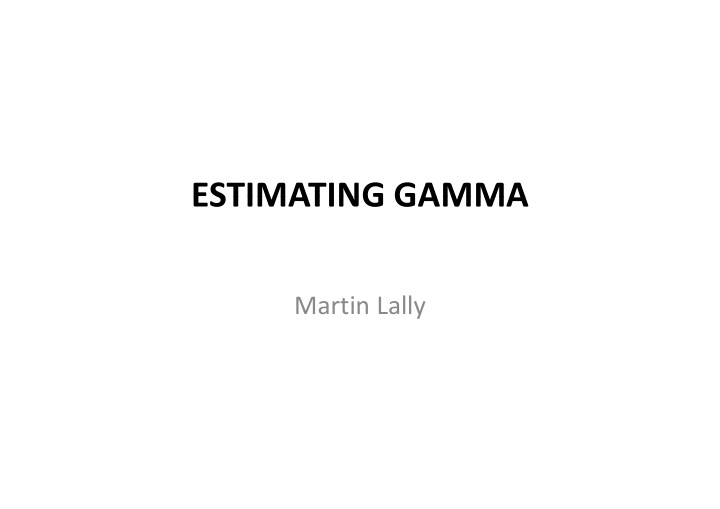



ESTIMATING GAMMA ESTIMATING GAMMA Martin Lally Martin Lally
The Utilisation Rate: Estimation Methods Method 1: The parameter is defined as weighted average of investors’ utilisation Method 1: The parameter is defined as weighted average of investors utilisation • • rates. If foreigners are ignored (consistent with the Officer CAPM), U = 1. Method 2: As above, but with recognition of foreign investors. This implies U is Method 2: As above, but with recognition of foreign investors. This implies U is • the proportion of Australian equities held by Australians, hence U = 0.70. Method 3: The proportion of credits redeemed with the ATO, and hence • U = 0.40 – 0.80. U 0 40 0 80 Method 4: Estimates based upon market prices: drop ‐ off studies, simultaneous • share and futures prices simultaneous share index and futures prices and share and futures prices, simultaneous share index and futures prices, and regressions of returns on imputation credit yields. Using post 2000 data, the results are 0.40, 0.13, 0.64, and ‐ 2.00. Ignoring the last one, the mean is 0.39. Method 5: Surveys of market practitioners. The most recent survey reveals U = • 0.75 amongst those who make explicit adjustments.
The Utilisation Rate: Choosing a Methodology The estimate should be The estimate should be • • Consistent with the definition of U Likely to give rise to a plausible value for the cost of equity (between seg and int) Reasonably precise Method 1 satisfies all requirements and is therefore recommended. • Method 2 satisfies the first and third requirements, but not the second because it generates • implausibly high estimates of the cost of equity. It is therefore ranked second. Method 3 satisfies only the third requirement, and is therefore ranked third. • Method 4 satisfies none of these requirements, and produces ancillary results that conflict with the • Officer CAPM, and estimates from dividend drop ‐ off studies may reflect broader anomalies, the actions of a small group of investors, and microstructure effects. Method 5 does not produce a point estimate. •
The Distribution Rate: Principles The Distribution Rate: Principles Theory ‐ based arguments for F = 1 (eg: the Officer framework assumes cash flows are level • perpetuities) are not justified. F is firm specific but firm specific estimates are precluded by the resulting incentive for firms to F is firm ‐ specific but firm ‐ specific estimates are precluded by the resulting incentive for firms to • • manipulate their dividend level. The choice is then between market and industry level estimates. • Industry averages will be contentious: which firms and which historical period? • This favours the market ‐ wide estimate. • F is the expected future rate, and historical data may underestimate it because undistributed • credits may be distributed, but there is no strong basis for believing this. So, historical data is used. ATO ‐ based estimates are contentious due to unexplained inconsistencies in the data. • Financial statement based estimates are free of these problems and have been audited. •
The Distribution Rate: Estimates The Distribution Rate: Estimates • Select the 10 largest ASX companies S l t th 10 l t ASX i • Use data from post 2000 Use data from post 2000 • F = DIST/(ATO TAX) /( ) • DIST = (FF DIV)*Tc/(1 ‐ Tc) • ATO TAX = DIST +B(2013) – B(2000) • Results for F vary from 100% (Telstra) to 53% (Woodside), with an aggregate ratio of 85% gg g
Recommend
More recommend